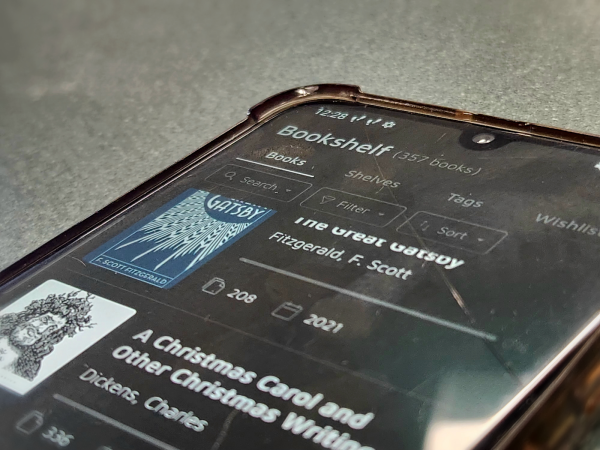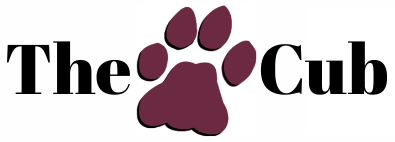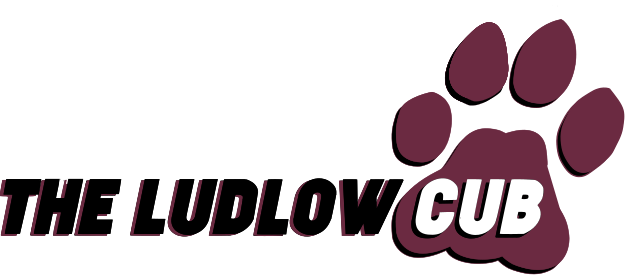The art of storytelling has been a part of human history for over 30,000 years. Every culture has its stories, many told orally or as drawings on cave walls. More modern forms of storytelling include books, plays, movies, and TV, telling longer and more elaborate stories. Books are a popular form of storytelling now, available in various formats such as physical books, e-books, and audiobooks, each with its pros and cons.
Physical hard copies of books have been around since about 500 B.C. and are what most people first think of when they hear the word “book.” They offer a nostalgic feel, and you can always see how close you are to the end of the story. Since most books were designed to be physical copies, they can have artistic layouts or embossed pages and textures that disappear when translated into e-books or audiobooks.
Junior Kelsie Blazejowski only reads physical copies of books, stating, “I like having something I can own. It’s nice to be able to take it out whenever I want rather than having to rent it from a library. My brain creates its own world, so I no longer see words but scenes. A screenbook doesn’t have the same effect.”
While physical books might have an ethereal, nostalgic quality, they also have some downsides. Long, detailed books might have a great story inside them, but carrying them around can become cumbersome. You also have to protect the books from damage, like water damage or page tearing. If you get them from a library, you have to remember to return them on time.
 Audiobooks were first invented in 1932 by a recording studio established by the American Foundation for the Blind. They made audio recordings of books into records, with each side capable of recording about 15 minutes of speech. The first audiobooks contained things like plays by William Shakespeare, but as they gained more popularity, more books were recorded on records. More companies that created audiobooks began to emerge in the years following, mostly making them for those who are blind. Now, audiobooks can be listened to by anyone, anytime, whether on a CD player or just a phone. Unlike normal reading, where you have to focus on the words on the page, audiobooks allow you to multitask, doing things like cooking, driving, or working. Audiobooks are good for those who have issues reading, like some forms of dyslexia, or those who are blind and cannot see a page at all.
Audiobooks were first invented in 1932 by a recording studio established by the American Foundation for the Blind. They made audio recordings of books into records, with each side capable of recording about 15 minutes of speech. The first audiobooks contained things like plays by William Shakespeare, but as they gained more popularity, more books were recorded on records. More companies that created audiobooks began to emerge in the years following, mostly making them for those who are blind. Now, audiobooks can be listened to by anyone, anytime, whether on a CD player or just a phone. Unlike normal reading, where you have to focus on the words on the page, audiobooks allow you to multitask, doing things like cooking, driving, or working. Audiobooks are good for those who have issues reading, like some forms of dyslexia, or those who are blind and cannot see a page at all.
Junior Nick Anderson mentioned that he likes audiobooks best, stating, “If I am going to read, I would really prefer to just listen to it, but I am able to read along with a physical book.”
Audiobooks aren’t perfect either. You no longer have the physical copy of something in your hand to read, and it can be more of background noise that can be tuned out easily. Some of the more delicate nuances in the book can be lost if you aren’t paying close enough attention to it or you happen to zone out. It’s hard to see the way the author intended for it to be read on the page since you are not reading on a page, just listening. It’s easy to miss chunks of the story being told if you are more focused on your other task at hand than listening to the book.
You might think that e-books have been around longer than audiobooks, but in that, you would be wrong. While the concept of e-books had been around since the 1930s, it didn’t come to fruition until 1971 with Michael Hart’s Project Gutenberg, creating a free library of e-books. The first “book” he started with was the Declaration of Independence, turning it into an online accessible format. The platform for e-books has just kept growing in the 50 years since its inception. They are convenient, they aren’t an extra weight to carry, you can change the font and text size, and you can read them on your phone or in the dark. You can buy copies of e-books on apps like Kindle, or you can use a library e-book app like Libby, which only requires you to have a library card from any library that uses their system, and you can borrow thousands of titles, with the only drawback being it functions as a library, and you can’t check out a book if someone else currently has it.
Junior Michele Winslow remarked, “E-books are convenient for reading anywhere, anytime, while physical books are nice for comfy at-home reads.”
E-books, while convenient, do have some small inconveniences as well. With an e-book, you no longer have the physical sensory interaction of holding a book and turning the pages, and it is much harder to gauge how much of the book is left, making cliffhangers and the like for endings that much more abrupt. It’s not great to stare at screens for hours on end, but with an e-book, that is what you are doing. It is easier to get interrupted while reading an e-book, especially on a phone getting notifications, or even just having to stop and find a charger.
Although there are all these types of books, no one type fits everyone. Each has its advantages, alongside some drawbacks. It really comes down to personal preference, whether you value something physical, something convenient, or something to listen to while doing something else.
As said by an anonymous junior, “I prefer physical books because I can go at my own pace and because of the sensory experience. I read with an audiobook in the background sometimes to keep me from spacing out and to help me process what I am reading easier.”
Junior Michele Winslow offered her opinion on the matter as well: “For school books, if it’s an audiobook I can listen along to it while reading the book, but if I am reading for entertainment, I just read e-books or physical books.”
The biggest takeaway from this comparison is that no version is right or wrong. Every type of book comes with its own pros and cons, and what matters most is what the individual wants to have their needs tailored to.

